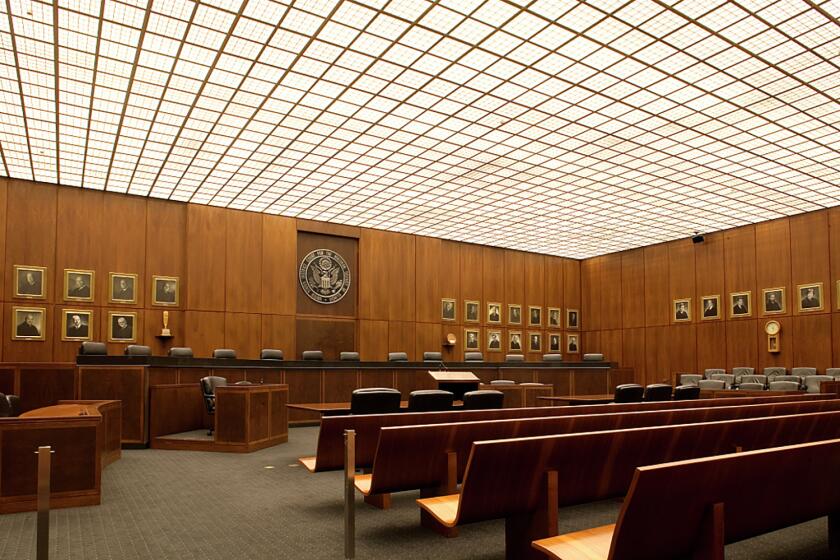Editorial: FAA needs to make thoughtful safety rules before drones deliver our packages or pizza
It’s a fantastic idea: Imagine your pepperoni-and-onion pizza arriving at the front door via drone, still piping hot from the oven, not cooling and congealing as it bounces around in a greenhouse-gas-emitting truck tooling through the neighborhood. And there’s a bonus: You don’t have to tip technology.
But it isn’t far-fetched. Engineers at Amazon, Google and NASA are hard at work on the technology to build high-speed aerial highways for cargo drones. Within a few years, it’s possible that there will be unmanned aircraft crisscrossing the skies, moving packages, mail and other goods 20 stories above our heads.
NASA calls this the next era of aviation. We call it a potential plague on humanity, unless federal transportation officials take the prudent steps necessary to balance public safety, environmental protection and quality of life against the wishes of companies eager to exploit this new technology.
The foremost concern is how to keep all those cargo drones from crashing into planes, buildings and each other. But there are many other issues to be resolved, including: Who will be responsible if drones crash and their cascading fragments hurt people or damage property? What about the visual and noise pollution of a gazillon blue Amazon drones zipping 200 feet above downtown L.A.? Will gaggles of drones disrupt the migratory pattern of birds and insects? There are likely to be effects that we can’t even imagine yet.
The Federal Aviation Administration currently requires a special permit to fly a drone for commercial purposes, and it’s relatively difficult to obtain. Next year, however, the agency is expected to finalize rules allowing commercial uses in limited circumstances, which will make it easier for drones to be used by farmers to monitor crops, power companies to check the integrity of the electrical grid and Realtors to snap jazzy bird’s-eye pictures of their listed properties. What those rules won’t allow is for drones to be operated outside the line of sight of a human, which is essential for cargo-moving drones.
That’s good. Drones can be helpful assistants to many industries, but the skies are not yet ready for new low-altitude shipping routes. Nor are they likely to be by 2017 — the timeline Google X’s Dave Vos recently outlined for the launch of the Project Wing drone delivery program — considering how much of the technological and regulatory framework has yet to be developed.
A number of things must happen before the feds should allow Google, Amazon or any other company to fly cargo drones — with or without individual operators — over inhabited places. First, we must have data that show the sense-and-avoid technology that drone manufacturers plan to deploy actually works. This won’t be as easy as it sounds. Although Google is already using accident-avoiding sensors for self-driving cars, it’s more complicated for drones because they fly at much faster speeds and have to sense things below and above them as well as to the front, side and back.
We also will need studies examining how drone traffic might affect migratory birds, or even flocks of city birds, and other wildlife that use the same airspace.
Finally, there must be a sensible system in place for managing drones’ use of the skies so that they aren’t routed into buildings or planes or endanger people on the ground. NASA is researching the various options for a low-altitude air traffic management system in collaboration with the FAA, academic researchers, manufacturers and companies, including Amazon and Google.
The options include requiring cargo drones to be equipped with the same location-transmitting devices that manned aircraft use; using “geofencing” technology to confine drones electronically to a specific path; and reserving a swath of altitudes primarily for drone use. Amazon, which wants to have a single operator flying a fleet of autonomous drones, favors that kind of segmented airspace. Drones would be operating up to 400 feet, with the skies above 500 feet left to traditional manned aircraft. It makes a lot of sense to separate drones from planes, whether that’s accomplished by full segregation or creating a low-altitude zone where small drones have the right of way.
What makes the most sense of all is for the FAA to move cautiously into this next era of aviation. Having a drone deliver your pizza may be cool, but it’s not worth sacrificing our safety and well-being or our environment.
Follow the Opinion section on Twitter @latimesopinion and Facebook.
MORE FROM DRONE WEEK
How I bought a drone and immediately became a danger to society
700,000 drones sold this year, but it only takes one to mess up a firefighting operation
More to Read
A cure for the common opinion
Get thought-provoking perspectives with our weekly newsletter.
You may occasionally receive promotional content from the Los Angeles Times.






